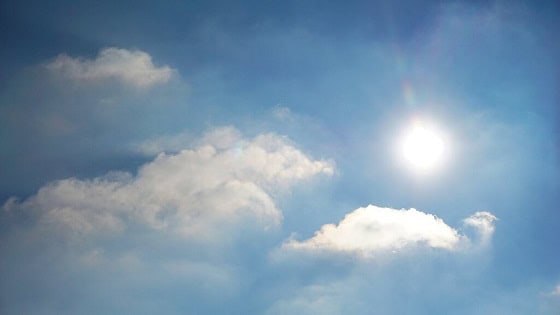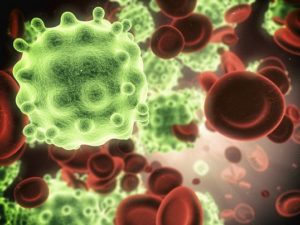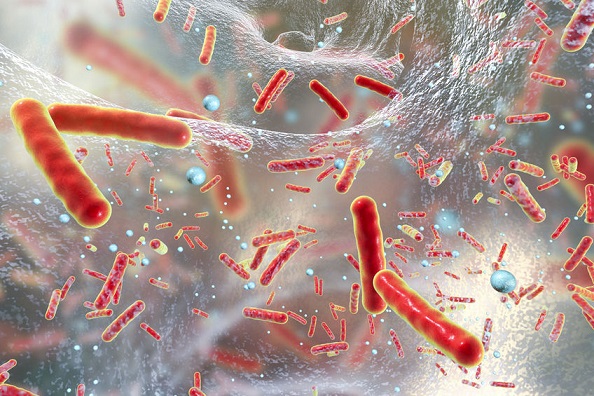 You probably haven’t heard of porphyrins, or perhaps you’ve about them on social media in passing. Nevertheless, porphyrins have heard of you, and right now, they may be fueling the creation of a brand new pimple.
You probably haven’t heard of porphyrins, or perhaps you’ve about them on social media in passing. Nevertheless, porphyrins have heard of you, and right now, they may be fueling the creation of a brand new pimple.
Bacterial porphyrins are the missing link in the chain of several acne phenomena which have left people scratching their heads. Make no mistake, you can easily cure acne without knowing the name porphyrins, let alone researching the subject deeply. But why settle for being an acne novice, when you can be an acne-clearing expert instead (if not quite a master, as nobody has reached that point yet).
Read on to discover the truth about porphyrins…
What they are
Porphyrins are a ubiquitous element which appear all across nature. They’re a molecule with a 4 tier ring-like structure, and this gives them an excellent ability to bind with metals, such as iron.
In plants, porphyrins bound with magnesium form the basic structure of chlorophyll, the light-absorbing molecule that gives plant their greenery. Porphyrins have immense light-absorbing abilities, and they capture the raw sunlight energy which is later converted to chemical energy forms like adenosine triphosphate (ATP). It’s the porphyrins’ absorption of red and blue wavelengths which cause chlorophyll to reflect out green.
In animals and bacteria, porphyrins bound with iron form haem, a molecule containing iron. This later forms the building blocks of haemoglobin, itself the building blocks of red blood cells. People with porphyria, a deficiency in enzymes used to convert porphyrins to haem, suffer from a lack of haemoglobin and sometimes must take supplements to combat poor blood oxygenation and its symptoms like fatigue and weakness.
Because they’re both based on porphyrins, haemoglobin and chlorophyll have surprisingly similar structures. Anyway, back to skincare. The key is that like humans, bacteria also produce porphyrins in order to form haem with iron.
Bacteria don’t produce haemoglobin like humans, but iron itself is key to all fungi’s survival, including bacteria and yeasts. It’s involved with energy metabolism, DNA replication and energy generation, the list goes on. Haem acts as the main reserve of iron in a bacterial cell.
This is why virtually all bacteria species on Earth produce porphyrins, and p.acnes bacteria, the species which acne patients worldwide are desperate to wipe out, is no exception. Every 15-45 year old has p.acnes on their skin, and therefore every acne patient has some porphyrins being generated. For many, it’s no problem and their skin stays clear. But it turns out that p.acnes producing too many porphyrins has a strong link to acne…
The first acne connection – vitamin B12
 Porphyrins pop up in random places all over the acne universe, and one of their main appearances is in the debate surrounding vitamin B12.
Porphyrins pop up in random places all over the acne universe, and one of their main appearances is in the debate surrounding vitamin B12.
You know this name: it’s the essential nutrient which vegans cannot acquire from the diet without animal sources, except via seaweed and slimy algae on beach rocks in a tidal cave in Japan somewhere. Vitamin B12 is required for energy regulation and mood-boosting neurotransmitters, so the vast majority of vegans are forced to supplement. But by taking huge shots of B12, many noticed savage outbreaks of acne. Twisting, burrowing red pimples which sprouted up from nowhere and stubbornly refused to go away. It’s still happening today, as B12 ranks alongside iodine as the nutrient which acne patients fear most. Since the 1960s, studies have attempted to establish the cause…
…and they eventually stumbled to the door of porphyrins. Bacteria such as p.acnes manufacture both vitamin B12 and porphyrins to survive, and both processes depend on the amino acid l-glutamine. Scientists found that when users supply vast quantities of B12, their bacteria also benefits, and they need to manufacture less of their own. So their available l-glutamine supplies get funneled towards creating porphyrins instead. Far more porphyrins are produced and linger on their skin surface.
As it happens, it’s mainly huge supplemental doses of B12 that cause acne. Normal dietary intakes are fine, and I recommend that you don’t worry about them. But porphyrins play a big role…
But why do they cause acne?
The dangers of porphyrins are simple: they oxidise squalene to form the free radical squalene peroxide. We’ve discussed this repeatedly on this website, as it’s part of the root causes of acne, but we’ve rarely covered the connection to porphyrins.
Squalene naturally makes up 12% of your skin’s oil, but the oxidised version is the strongest acne-causing substance known to mankind. Firstly, squalene peroxide triggers higher sebum (oil) production itself. Secondly, it’s an extremely potent oxygen scavenging molecule. This decreases oxygen levels in skin pores, making them a far more suitable home for p.acnes, an anaerobic bacteria (bacteria which thrive without oxygen).
Squalene can oxidise without porphyrins being involved – air pollution, cigarette smoke, benzoyl peroxide. But porphyrins are one of the most reliable kickstarters of the process. If they ultimately cause more bacteria to grow in a deoxygenated skinpore, this can create an exponential increase in acne, as yet more porphyrins will be generated. This partly explains why some teenage and adult acne is so stubborn.
The porphyrin-squalene connection was initially confirmed in a 1986 study, and a recent 2023 study found a direct correlation between porphyrin levels and squalene peroxide in the skin of acne patients.
The reason is known too, and it’s down to their solar radiation absorption capacity, the same that helps porphyrins to capture sunlight in plant chlorophyll. Porphyrins capture wavelengths with a maximum absorption at 407-420nm, and this excites them, causing them to generate singlet oxygen, one of the most dangerously potent free radicals. This is fine in low levels, but too much – well, you’ve guessed it. They run rampant, overwhelm antioxidants and squalene peroxide (and acne) is the result.
So sticking with vitamin B12, here’s the chain of events…
- Increasing B12 causes p.acnes to divert l-glutamine to producing porphyrins. Levels soar far beyond the average person’s.
- Porphyrins absorb solar radiation and produce singlet oxygen (free radical) in response.
- This oxidises intact squalene in your oil, and forms the free radical squalene peroxide.
- This stimulates further sebum production and p.acnes infestation by decreasing oxygen in skin pores.
- Your face bursts into acne-hood.
However, porphyrins have connections to skincare characters other than B12…
Connection 2 – seasonal acne
 Seasonal acne is an absolute nightmare to predict, as some people complain of redness and blotchiness during summer, while others report reduced pimples and a golden glow. Everyone has a different story, but porphyrins are one player in this confusing storm. Just as porphyrins can damage your skin, they can also destroy the p.acnes bacteria that produces them.
Seasonal acne is an absolute nightmare to predict, as some people complain of redness and blotchiness during summer, while others report reduced pimples and a golden glow. Everyone has a different story, but porphyrins are one player in this confusing storm. Just as porphyrins can damage your skin, they can also destroy the p.acnes bacteria that produces them.
Activation of porphyrins within bacteria by wavelengths of 407-420nm causes them to release singlet oxygen. The bacterial cell then experiences catastrophic membrane damage, with an efflux of potassium from cells and a huge loss of phosphate, and leakage of various cytoplasmic components. The p.acnes self destructs from within, and the stimulation for acne fades. All this was discovered in a 2003 study.
The interesting thing is that the same process also hurts human skin – the generation of singlet oxygen and squalene oxidation discussed above. This almost certainly explains some of the great unpredictability that acne patients have during summer. If you visit the beach and porphyrins are stimulated by light, will the balance tip towards creating new acne, or destroying p.acnes colonies? It’s hard to tell.
Perhaps if your p.acnes colonies are severely overgrown, this will only make a dent in them, and the photostimulation of porphyrins will become an utter nightmare. But if your p.acnes levels are just moderate, then you might gain more disproportionally. You could also experience a worsening in acne initially, as the porphyrins detonate savagely, but a large improvement later, as the p.acnes cells are now dead.
According to the study: “The efficiency of bacterial photokilling by naturally produced endogenous porphyrins is relatively low“. They said that multiple rounds of 407-420nm light exposure may be required, which would also apply to sunlight.
Porphyrins are also why blue light devices have proven acne success. I only recommend these high tech acne gadgets if you have loads of money to burn, but they once slashed acne by 30-50% in a study. Again, stimulating porphyrins until they destroy bacterial cells is the reason. Red light devices don’t work as well; while their waves penetrate more deeply, reaching lower layers of the skin, they fail to activate porphyrins.
Confusion is rife, but porphyrins could be involved in any summer fluctuations in skin quality you’ve experienced.
It also depends on luck
 It now turns out different strains of p.acnes bacteria produce different levels of porphyrins, thus explaining why some strains are far worse for acne.
It now turns out different strains of p.acnes bacteria produce different levels of porphyrins, thus explaining why some strains are far worse for acne.
P.acnes is divided into 3 large families, and hundreds of substrains within each. Overall, types 1a and 1b are the most malicious while 2 and 3 are gentler. There are endless differences between strains. Savager ones produce more lipases, enzymes which they use to digest fat for energy, but also create inflammatory by-products. Deadly strains can produce more hyaluronidase enzymes, which consume hyaluronic acid, and contain more antigens like dermatan sulfate which our immune systems sense and assault.
In 2016, scientists took their porphyrin quest to the next level. They analysed 4 p.acnes strains from the malicious IA-2 clade, and 3 strains from the healthy type II. The conclusion was clear: those correlated with acne produced far more porphyrins.
The types of porphyrins were identical, with coproporphyrin III dominating in all seven strains. But the quantities varied wildly; type 1A-2 produced an average of 6.5 µM, far outstripping type II at 1.1µM. The scientists then delved deeper and discovered a gene in type II called deoR, which repressed their porphyrin production. Those in clade IA-2 showed no signs of this gene.
The strain differentiation even affected vitamin B12. While normal p.acnes strains began producing more porphyrins when their B12 was sufficient, there was a porphyrin ceiling in the healthy strains. In the four IA-2 strains, porphyrin production rose from 6.5 µM to 9.2 µM. In the three type II, it remained at 1.1µM.
B12 is another supplement with wild variation in testimonials, with some forum users shrugging their shoulders, while others type out tales of woe. The various p.acnes strains might explain this again.
The scientists also identified the gene involved with vitamin B12 biosynthesis, called cbiL. This was suppressed when more outside vitamin B12 was applied, reducing the p.acnes’ own production. CbiL fell in all 7 strains, yet only clade IA-2 strains began pumping out more porphyrins in reponse.
If you’ve been unlucky enough to brush against someone in an airport baggage check queue and acquire the most malicious strains, you may be cursed with higher porphyrin production.
Porphyrin-pumping super strains
4 years later, scientists reentered the microscopic world of bacteria, and attempted to analyse 16 different p.acnes strains. They even tested different species of bacteria, including more minor members of the Propionibacterium family: P. granulosum, P. avidum, and P. humerusii, which are all found in humans. P. granulosum for example, appears in oily areas of the face, but in far fewer numbers than p.acnes
The results backed up those from 2016. Type I strains produced an average of 2.67μM of porphyrins, type II produced 0.04μM, and type III produced 0.36μM. All this mirrors the results in real world acne patients, who have far more abundant type 1 strains, ruling over reduced and outnumbered colonies of healthy II and III which are barely clinging on.
As for the other species, P. gransulosum, P. avidum, and P. humerusii averaged at 0.30μM, and they didn’t increase their output after vitamin B12 supplementation. P.acnes type I is the exceptional in the Propionibacterium family when it comes to porphyrin chaos, and it’s also the most correlated with acne. Its microscopic cousins seem to just produce the porphyrins they need and leave it be.
Best of the rest
Porphyrins are also able to increase inflammatory chemicals more directly, as the immune system senses their presence, suspecting their bacterial origins. This study found that porphyrins from p.acnes increased interleukin-8 (IL-8), a classic pro-inflammatory which is elevated in acne patients. This is a much more direct connection to acne than the unpredictability of the singlet oxygen release.
There’s also different porphyrins in nature, produced by different bacterial strains. P.acnes mainly produces coproporphyrin III, with small amounts of protoporphyrin IX. Staphylococcus aureus, another inflammatory skin bacteria, mainly produces uroporphyrin. These could have different properties which are undiscovered.
There’s even a strange interaction between the two: a study found that the greater the coproporphyrin III produced by p.acnes in the nostrils, the more S. aureus was able to create impenetrable biofilms. These are hardy structures which make bacteria extremely resistant to destruction.
Verdict
The porphyrin sub-zone of the acne universe is now throwing up all sorts of interesting facts, which one day we will hopefully be able to exploit.
There’s also oddities like this study from 2017, where scientists used porphyrins to measure benzoyl peroxide, and how well it was reducing bacteria. As porphyrins absorb wavelengths of 407-420nm, they gain a bright fluorescence which is easily visible under a microscopic. By watching this fluorescence dwindle like a family of dying fireflies, they could prove that the benzoyl peroxide was succeeding.
Note that I don’t recommend BP, but it’s interesting anyway. Antibacterial remedies rely on faith somewhat. If tea tree oil clears your acne, then you can assume it’s because of the antibacterial terpinenin-4-ol it contains, but you can’t guarantee it.
Porphyrins explain why vitamin B12, different seasons, and p.acnes substrains cause acne. They almost certainly affect more that we don’t know about (yet).
Thanks for reading!
